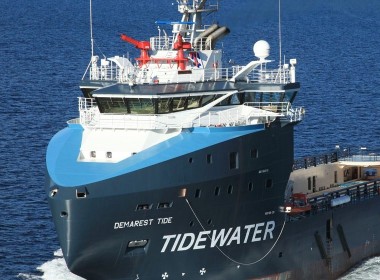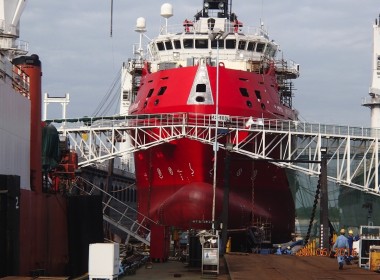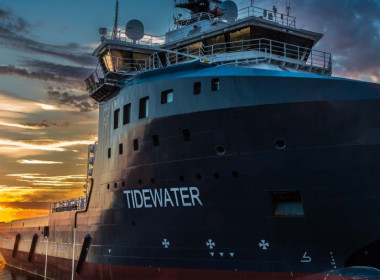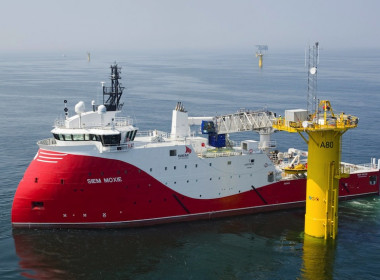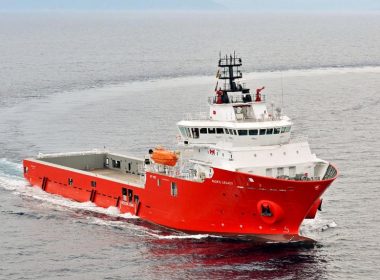COLUMN | Tidewater – record results, but what happens next? [Offshore Accounts]

On Friday, March 1, Tidewater reported its fourth quarter results, and they were epic.
For the full year 2023, the company smashed through the US$1 billion revenue mark, and for the quarter it passed US$300 million, Tidewater’s highest quarterly revenue in eight years. Over US$100 million of the annual revenue came from Italy’s ENI, Tidewater’s largest customer.
Between October and December, the average day rate across the company’s fleet increased to US$18,066 per day, US$201 higher than in the third quarter of 2023. Tidewater said that its “composite leading edge term contract day rate” stood at US$29,511, which was US$902 higher than the third quarter of 2023. This is a measure of its current fixtures weighted by size, reflecting mostly the rates for its largest platform supply vessels (PSVs).
For the final 92 days of 2023, Tidewater reported net income of US$37.7 million, up from US$11.5 million in the July to September quarter, and net cash provided from its operations increased to US$47.2 million, an increase of US$12.3 million from the previous quarter. Free cash flow as a whole amounted to US$61 million, more than double that achieved in the prior quarter. For the whole of 2023, Tidewater made a net profit of US$95 million and generated US$105 million from its operations.
Shares up 14 per cent, enterprise value now c. US$5 billion
By all measures this was a great achievement, and the stock price surged. When the company reported its third quarter results in November, the market was disappointed and the shares were marked down 14 per cent to US$60 per share. This time round, investors were ecstatic, and the shares were up 14 per cent on the day to over US$80 apiece, pushing the company’s market capitalisation to over US$4 billion.
Together with its combined short and long-term debt of about US$730 million, that gives the company an enterprise value of around US$5 billion. Even after buying back US$35 million of its own shares in the quarter at levels far below Friday’s close, Tidewater boasted US$278 million of cash on its books on December 31.
Each Tidewater ship is worth US$23 million
Not bad for a company with only 198 anchor handlers (AHTS) and PSVs, plus a motley collection of 23 other vessels, mainly crewboats and tugs mostly chartered to Chevron in Angola. The market currently values every AHTS and PSV in the Tidewater fleet at around US$23 million each, when we strip out the cash, which is amazing given the average Tidewater fleet age is now 13 years. We’ll come to that later. Mark those two facts as red flags.
The company has powered through its fleet reactivation and disposal programme with only two vessels stacked at the end of last year, one of which is the 2003-built, 80-tonne bollard pull AHTS Pacific Retriever which is being widely bid for sale on Namibia. A year ago, the company had 14 stacked vessels, but in 2023, it disposed of 15 ships, seven from its active fleet and eight from cold stack.
Chouest, Hornbeck and Bourbon in the dust
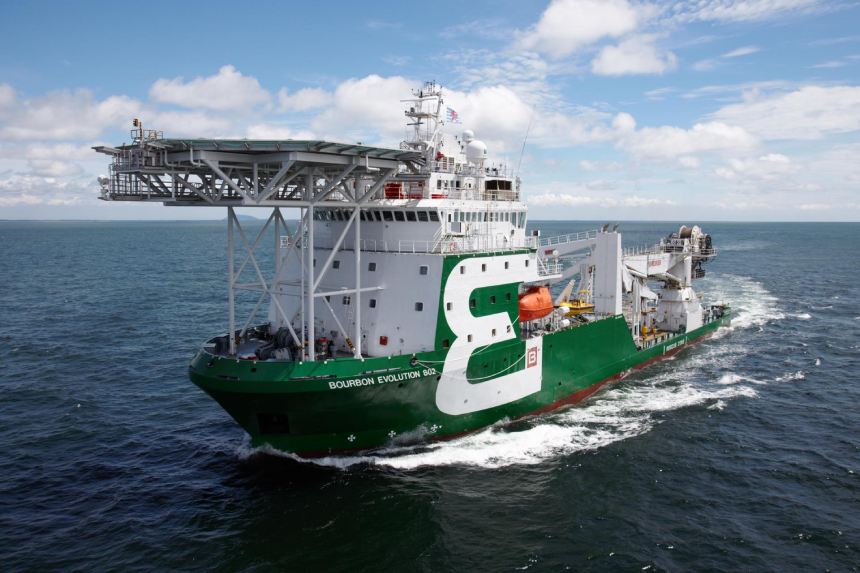
Its rivals Edison Chouest, Hornbeck Offshore, and Bourbon all suffer from having numerous vessels cold-stacked, out of service for years, and in need of expensive reactivation, which they struggle to afford. This hinders their ability to compete with Tidewater, and keeps supply out of the market, whilst Tidewater, with its robust balance sheet, makes out like a proverbial bandit.
Hornbeck is due to list on the New York Stock Exchange, but since an initial offering filing in December, there has been silence. Looking at Tidewater’s results, Hornbeck’s owners and management must be ruing every day of delay, the additional resources needed to get the business working at full capacity so close, but so far out of reach.
The same at Bourbon, still owned by a collection of banks after its dramatic December 2019 restructuring filing, and perpetually rumoured to be close to restructuring, but seemingly never quite getting there. Bourbon was last seen loading a dozen vessels from cold lay-up in Abidjan and placing them on a heavy lift ship for delivery to Batam, Indonesia a month ago, where they will continue to be stacked, whilst the company holds out the begging bowl to its financiers to reactivate them.
The lesson from Tidewater and all the drillers is that you can’t fix the business until you have fixed the balance sheet.
What was driving the improvement?
When we cautioned investors not to panic in November, we highlighted three reasons to be optimistic about Tidewater, and those three reasons should continue to power the company to better results in 2024.
What are they? To remind you:
- Momentum, Momentum, Momentum
Firstly, there is the simple fact of momentum. Tidewater still has many vessels locked into low rates in contracts fixed in 2021 or early 2022. When these contracts end and the vessels are fixed into new charters, those new charters are at today’s much higher rates. Even if the “composite leading edge term contract day rate” only moves ahead by few percentage points up from US$29,511, there are huge benefits for the company when a legacy contract of, say, US$15,000 per day expires, and the same vessel is locked in at US$29,000.
This momentum explains why the company expects its average day rate to increase by another US$4,000 in 2024, most of which will fall straight to the bottom line. With 25 per cent of the fleet not contracted in 2024 and able to roll over onto market rates, Tidewater should generate another US$292 million of free cash flow this calendar year, so by the end of 2024, I would anticipate the company to be making over US$100 million in net income per quarter, more than it made in full year 2023. Tidewater still has more juice from the legacy PSVs rolling over from long-term charters in 2024.
- Middle East has to improve, surely?
As we highlighted in November, Tidewater’s 45 vessels working in the Middle East once again made a full year loss of US$1 million in 2023, but finally turned a profit of US$2 million at a regional level in the fourth quarter. This was driven by a small increase of US$550 in average day rates for the 18 small AHTS working there, and by ten percentage points increase in the utilisation of those vessels.
Compare that to the US$11 million in regional profit made by just 18 vessels in Asia Pacific and you see the problem and the opportunity. Rates in the Middle East remain low, and you have to ask why Tidewater is persevering with 20 medium sized PSVs there, earning 40 per cent less than the same types of ship earn in West Africa or Asia Pacific.
Through 2024, we expect to see Tidewater continue to eke out gains in the Middle East, but that the region will continue to underperform the business in the rest of the world. It will continue to drag down performance overall, but will improve year on year.
Several of Tidewater’s rival owners in the small AHTS business in the Arabian Gulf are being touted for sale, as their owners seek to cash in on improved market conditions and the lack of proper competition standards in the area mean that this is one of the few markets where Tidewater could make acquisitions without fear of any anti-competition probes.
Would it be worthwhile to pour more capital into this sink?
If we value the Tidewater fleet there at US$13 million per vessel due to the smaller size of the assets, having US$585 million of capital tied up generating (checks calculator) less than a one per cent return on capital is still an epic fail, albeit one that will ameliorate in the next 12 months.
Celebrating the fact that the company’s 45 vessels there could earn a return of one or two or even three per cent annual return in a booming market after years of losses suggests that the whole business should perhaps have a large “for sale” sign placed over the door and the proceeds returned to shareholders.
Am I advocating the breakup of Tidewater? No, but extracting value in the Middle East should be a prime objective for 2024.
Hadi Al Hamman’s Horror Show
The fact that Bahraini/Saudi Arabian offshore support vessel (OSV) owner Hadi Al Hamman has been slated by the International Transport Workers’ Federation for failing to pay its seafarers for five months is symptomatic of the problems.
Rivals going bust is hardly a sign of a buoyant market, and the reminder that Bahrain still hasn’t ratified the Maritime Labour Convention 2006 shows us this is a market where poor pay for seafarers, a complete lack of workers’ rights both ashore and at sea, and abusive employers are rampant.
- Weak anchor handlers are an opportunity
Tidewater has done a great job of raising utilisation and day rates for PSVs. It remains a PSV-centric business: its 69 large PSVs with over 900 square metres of clear deck space achieved 86 per cent utilisation in the fourth quarter and an average day rate if US$23,240 per day, whilst its 72 medium-sized PSVs achieved 88 per cent utilisation and US$17,734 average day rates. Around 76 per cent of the company’s fourth quarter revenue came from PSV operations.
As we noted in November, given the need for vessels to undergo maintenance and dockings and to mobilise between contracts, it is going to be hard for the company to improve much on that PSV utilisation, so future improvements can come purely from day rate increases and contract resets.
Again, we highlight that much opportunity remains in the anchor handling market. Tidewater operates a total of 57 AHTS, but this 30 per cent of the fleet underperformed again in the third quarter. The eleven large anchor handlers of 16,000bhp (11,931kW) or greater saw their average day rates drop by ten per cent, whilst utilisation rose five percentage points to 75 per cent, well below the utilisation of the PSV fleet.
The 21 medium-sized anchor handlers in the 8,000bhp (5,965kW) to 16,000bhp range saw their average utilisation drop by six percentage points, negating a US$500 increase in average day rates. The 25 AHTS that are smaller than 8,000 bhp rose both in terms utilisation and average day rate.
The trend is heading in the right direction, but painfully slowly. To deliver on its potential, Tidewater needs to juice its AHTS fleet in the same way as it has for its PSVs. Yes, 24 AHTS are working in the Middle East, which explains part of, but not all, the problem.
We reiterate our position that given the higher capital cost of building a large anchor handler compared to a large PSV, one might expect rates for this category to eventually surpass large PSV rates. In the last peak of 2013, large AHTS were fixed on term charters higher than US$40,000 per day. If this happens this would help Tidewater’s bottom line materially.
What next?
Having concluded that Tidewater will have a bumper 2024 and should deliver US$400 million in net income, we still struggle with the US$5 billion enterprise value for the business.
The company has resolutely not addressed its fleet age problem. An average fleet age of 13 years today suggests that seven to twelve years from now, Tidewater will meaningfully cease to exist as a business, unless it begins a programme of fleet renewal.
Even if it pays out its entire net income every year from 2024 onward for a decade to its shareholders in buybacks and dividends, Tidewater will struggle to justify the current US$80 per share price. In the short term it may trade as high as US$100 or even US$120 per share, but Tidewater is now a business running on borrowed time and at some point this will lead to a rerating of the shares.
Problems of success, crossroads ahead
Tidewater has achieved a problem of success that most of its peers can only envy. Valuing the business at US$5 billion means Tidewater is priced at or above newbuild parity. It may be able to achieve some acquisitions in 2024 or 2025, but the competition authorities are going to be much more alert to its market dominance, and there are few sellers as desperate as the owners of Swire Pacific Offshore and Solstad’s banks were in 2022 and 2023.
Either Tidewater is going to build something new soon, or somebody else is going to lead on the future fleet investment. In that situation, Tidewater will simply become a cash cow with an ageing fleet. The cash cow scenario is probably very attractive to the top management team, which is strong on accountants and financial engineers, rather than mariners and actual engineers.
Another US$50 million of share buyback authorization in the coming quarter rewards its management’s stock options handsomely. The future probably involves taking on a lot more leverage and increasing share buybacks to juice their own stock grants.
Investing in new tonnage to replace the 140 PSVs in the Tidewater fleet in a phased and progressive manner would raise the uncomfortable problem that approximately 50 per cent of the company’s future free cashflow might need to be diverted to future investments in the coming decade, rather than dividends or buybacks. Investors might not like that so much, even if it would create a sustainable business with a future that extends beyond 2031 when the fleet hits twenty years of age.
The fact that the company shut Swire Pacific Offshore’s seafarer training centre in Singapore tells you a lot about Tidewater’s short-term philosophy. At a recent conference Tidewater CEO Quintin Kneen urged the industry to exercise discipline and not to succumb to the siren call of customers offering long term newbuild contracts.
He would say that, wouldn’t he?
And finally… WTF?
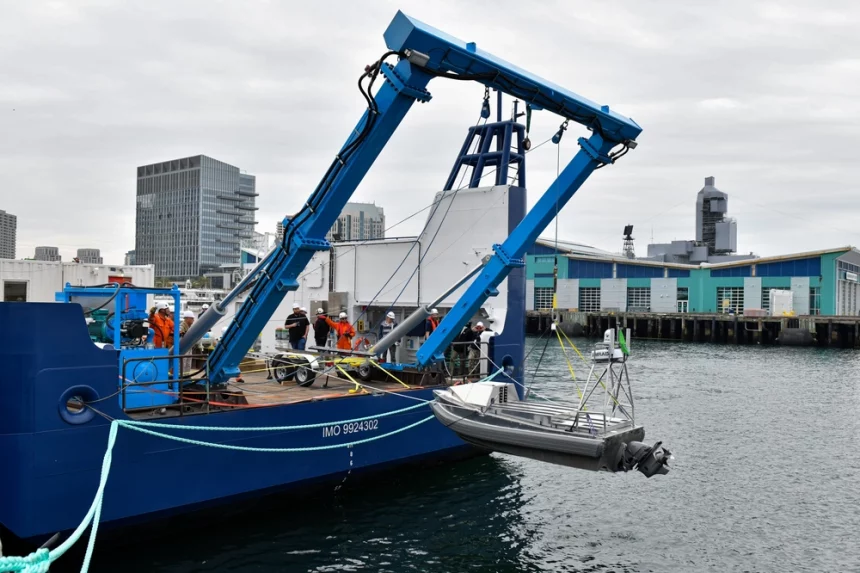
We usually close with “Further Reading” but this week we close with this bizarre photo from the United States Navy and Ocean Infinity. Entitled “Armada 7807 launches GARC” it shows crew members of Ocean Infinity’s Armada 7807 recovering a global autonomous reconnaissance craft (GARC) from Unmanned Surface Vessel Squadron 3 (USVRON 3) out of the water from the stern of the vessel while pierside in San Diego Bay.
The Navy says that the 16-foot (4.87-metre) GARCs built by Maritime Applied Physics Corporation enable research, testing, and operations that will allow integration throughout the surface, expeditionary, and joint maritime forces.
So many questions… Why are they using an A-frame over the stern of a vessel to recover a USV to a road trailer? If this is the most-high tech and sophisticated navy in the world, I worry for the future of the free world.
A simple internet search would suggest to even the most zealous naval commander that there are better ways of doing this than using a stern-mounted A-frame, better platforms to use than a vessel with that particular stern design, and better locations than pierside in San Diego.


